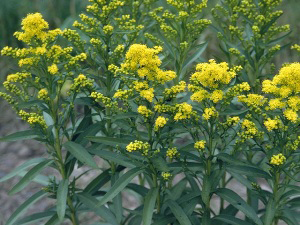The flowers of stiff goldenrod attract many pollinating insects, including bees, wasps, flies, beetles, and butterflies (especially Monarchs). In addition, the plant is a source of food for the greater prairie chicken and eastern goldfinch# which eat the seeds; many herbivores browse on the leaves during the early states of its growth and development.
Photo Credit: © W.D. Bransford, Lady Bird Johnson Wildflower Center, wildflower.org.
Solidago rigida
Common Name: stiff goldenrod
Other Scientific Names: Oligoneuron rigidum
Plant Functional Group: Forb
Class > Order > Family: Magnoliopsida > Asterales > Asteraceae
What does the species look like?
Stiff goldenrod is an erect, perennial, herbaceous plant growing 1 to 5 feet tall. Its flowerheads consist of tiny, yellow flowers grouped tightly, each having both male and female parts, with the flowerheads then grouped into flat-topped clusters.
Stiff goldenrod is found on open sites, in dry, rocky, or sandy areas.
Where is the species found?
States & Provinces
AB, AL, AR, CO, CT, DC, GA, IA, IL, IN, KS, KY, LA, MA, MB, MD, MI, MN, MO, MS, MT, NC, ND, NE, NJ, NM, NY, OH, OK, ON, PA, RI, SC, SD, SK, TN, TX, VA, WI, WV, WY
Which phenophases should I observe?
Do you see...?
Leaves
Initial growth More...
Leaves More...
Flowers
Flowers or flower buds More...
How many flowers and flower buds are present? For species in which individual flowers are clustered in flower heads, spikes or catkins (inflorescences), simply estimate the number of flower heads, spikes or catkins and not the number of individual flowers.
Less than 3 3 to 10 11 to 100 101 to 1,000 More than 1,000
Open flowers More...
What percentage of all fresh flowers (buds plus unopened plus open) on the plant are open? For species in which individual flowers are clustered in flower heads, spikes or catkins (inflorescences), estimate the percentage of all individual flowers that are open.
Less than 5% 5-24% 25-49% 50-74% 75-94% 95% or more
Fruits
Fruits Solidago rigida , the fruit is very tiny and seed-like and is crowded into a small spent flower head. The seed-like fruit has a tuft of white to light brown hairs and changes from yellow-green to white or brown, and drops or is blown from the plant. Do not include empty flower heads that have already dropped all of their fruits.More...
How many fruits are present?
Less than 3 3 to 10 11 to 100 101 to 1,000 More than 1,000
Ripe fruits Solidago rigida , a fruit is considered ripe when it has turned white or brown, or when it readily drops or is blown from the spent flower head when touched. Do not include empty flower heads that have already dropped all of their fruits.More...
What percentage of all fruits (unripe plus ripe) on the plant are ripe?
Less than 5% 5-24% 25-49% 50-74% 75-94% 95% or more
Recent fruit or seed drop More...
How many mature fruits have dropped seeds or have completely dropped or been removed from the plant since your last visit?
Less than 3 3 to 10 11 to 100 101 to 1,000 More than 1,000
What do these phenophases look like?
There is currently no photoguide available for this species. If you'd like help us create one, use the guidance document and species template provided here . Then send it via email to education@usanpn.org when it is complete.
